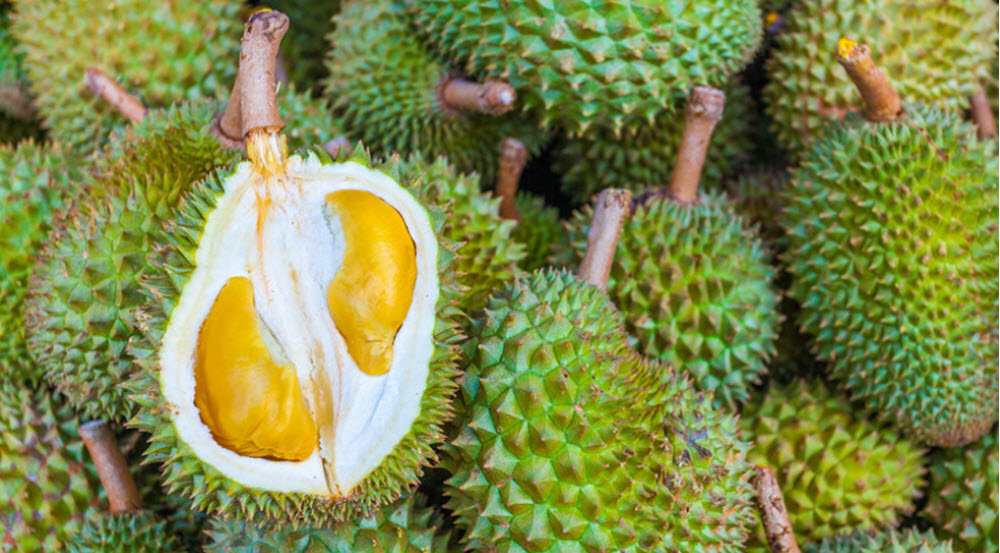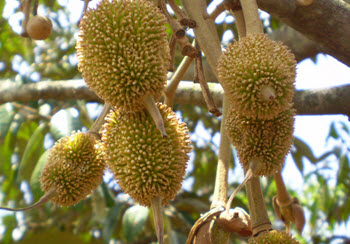Contents
Durian is the fruit produced by various species of tree beloning to the genus Durio in the family Malvaceae. There are 30 species in this genus, and nine of them are grown for their fruit. Within the species, many different variants exist, including approximately 300 named varieties grown in Thailand and roughly one hundred in Malaysia.
If you encounter durian fruit in a country where Durio trees don’t grow, it is most likely one from the species Durio zibethinus since this species is by far the most common one in the international fruit trade. There are over one hundred cultivars of D. zibethinus and the properties of the fruit can vary significantly between cultivars.
Many durian species, variants and cultivars produce fruit that smell really horrible, which is why durian bans are quite common for indoor places in areas where durian is popular. There are for instance many hotels in southeast Asia that doesn’t allow durians.

Scientific classification
| Kingdom | Plantae |
| Order | Malvales |
| Family | Malvaceae |
| Subfamily | Helicteroideae |
| Tribe | Durioneae |
| Genus | Durio |
The nine species
As mentioned above, nine species of Durio are grown for their fruit.
| Species | Info |
| Durio zebethinus | This is the most common Durio species in the international fruit trade. Many different cultivars exist, producing various types of fruit. |
| Durio dulcis | Also known as Red durian, since the husk of the fruit is dark red to brown-red.
The fruit flesh is dark yellow. It smells like turpentine but tastes like caramel. This is one of the sweetest durian fruits. |
| Durio grandiflorus | Endemic to Borneo.
The fruit has yellow flesh. |
| Durio graveolens | Also known as red-fleshed durian.
The husk is orange-yellow, while the flesh is crimson.
The smell is actually nice and reminds us of roasted almonds. The flesh tastes sweet.
|
| Durio kutejensis | The open flowers smell like carrion.
The fruit flesh is yellow with a mild sweet taste and a creamy texture. |
| Durio lowianus | The fruits are oval-shaped with yellow flesh. |
| Durio macrantha | The fruits are small and virtually odour-free (!).
The fruit flesh is of a pale yellowish tone. |
| Durio oxleyanus | The fruits are small and round.
The fruit flesh is yellow, smooth-textured and sweet. |
| Durio testudinarum | Also known as tortoise durian.
This is a self-pollinating species.
The fruit flesh is pale yellow and produces a very strong smell. |
Durian suluk is a natural hybrid between D. zibethinus and D. graveolens. The fruit tastes a lot like that of D. Zibethinus, but with overtones of burnt caramel.
Folk medicine
Traditional Chinese medicine
 In traditional Chinese medicine, the durian is regarded as having warming properties.
In traditional Chinese medicine, the durian is regarded as having warming properties.
In situations where warming is not desirable, water is poured into the empty shell and drunk once the fruit flesh has been eaten. This is believed to counteract the warming. Another solution is to eat durian together with mangosteen, since mangosteen is considered cooling.
Malaysia
In Malaysia, a decoction of leaves and roots are used to treat fevers. Leaf juice can also be applied directly to the head of the feverish person.
Java, Indonesia
On the island of Java, durian is believed to be an aphrodisiac.
Local customs
- Do not drink coffee and/or alcohol while eating durian.
- Do not drink alcohol soon after eating durian, because it will cause indigestion and bad breath.
These customs might be based in the fact that durian has a high sulphur content, and that this inhibits the activiy of aldehyde dehydrogenase, making it more difficult to clear toxins (such as ethanol) from the body.
